Tilmanstone Colliery

Tilmanstone Colliery, also known as the East Kent Colliery, was begun near the village of Eythorne in 1906 by Arthur Burr. Initially managed by Arthur Burr’s Foncage Syndicate, it was later managed by his East Kent Colliery Co. Ltd.
Like all the Kent collieries, Tilmanstone Colliery suffered from bad geology and poor investment. In 1909 a hoppit (hoist bucket) fell down the shaft, killing three men and destroying the pump pipes. One thousand gallons of water a minute poured into the pit and work was abandoned for nine months. Work on sinking the shaft started again in 1910, but the shaft consistently hit water which brought with it tons of sands. Sinking continued slowly until electric pumps were installed in 1912.
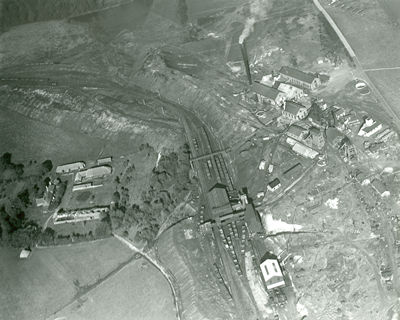
Aerial view of Tilmanstone, 1950's

Start of No. 1 Shaft, Tilmanstone Colliery. 1906
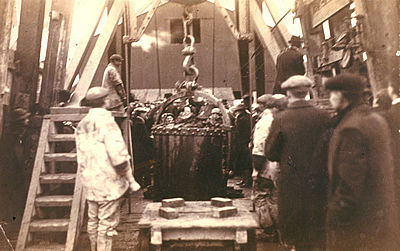
1st hoppit of coal
The coal seams were reached in 1912. In March 1913 the rich Beresford seam was hit at a depth of 1560 ft. (476 m.) and commercial production of coal finally commenced. Despite this, the company was in serious financial trouble and went into receivership in 1914. Burr was dismissed and the shareholders rescued the company and took over the management.

Tilmanstone Colliery 1914
A promotional drawing for a stockbrokers certificate. This was part of the campaign to get new investors after Burr was dismissed and the company restructured
Despite being given a new lease of life, the colliery still struggled and lost money every year. In 1926 the Colliery was again in receivership and it was sold to Richard Tilden Smith and his Tilmanstone (Kent) Colliery Ltd. The rich Milyard seam was hit in May 1930 at a depth of 3,035 ft. (925 m.)
Richard Tilden Smith's aim was to export coal from Dover, but the only method of transportation available was via rail. Transporting via train was not only slow, but expensive. Smith proposed to build an arial ropeway to move coal from the Colliery directly to Dover harbour, but his application was turned down. However he managed to get agreement from Dover Harbour Board to site a 5000 ton Bunker on the Eastern Arm, and contributed £25,000 to the building costs.
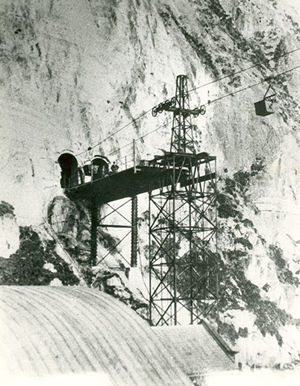
Ariel ropeway exiting the cliff face.
When the ropeway was built it was capable of moving 120 tons of coal per hour, each bucket holding 14.5cwt. A bucket left the colliery every 21 seconds and they were spaced 46 yards apart.
The first section of the ropeway was opened on October 12th 1929, between the Colliery and East Langdon. The “Cormister” was the first vessel to be loaded with Tilmanstone coal on February 14th 1930, when Tilden Smith himself pressed the button. The coal was loaded at 500 tons per hour.
Tilden Smith died in December 1929 and in 1937 his interests were sold to the Anglo-French Consolidated Investment Corporation Ltd. They planned to develop the lower seam as the Colliery was not working to it’s full capacity.
Tilmanstone was extensively modernised after nationalisation in 1947 but was always considered uneconomic by the NCB. The Colliery was planned to close as early as 1967, but ultimately it survived until 1986.
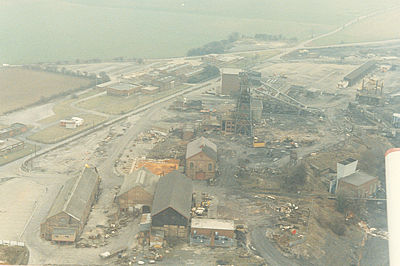
Colliery offices, main repair workshops, stores and winding engine house No 1 Shaft taken during the demolition of Tilmanstone, note the collapsed headgear at the centre rear of the photo.
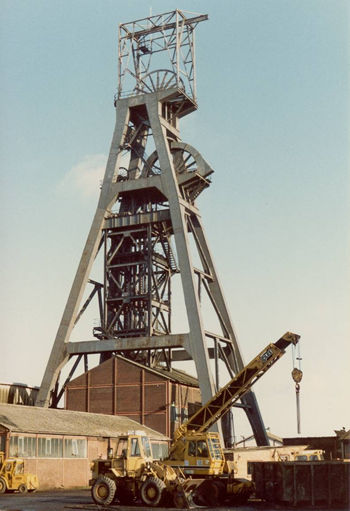
Head Frame of the Downcast Shaft used for coal winding 198.